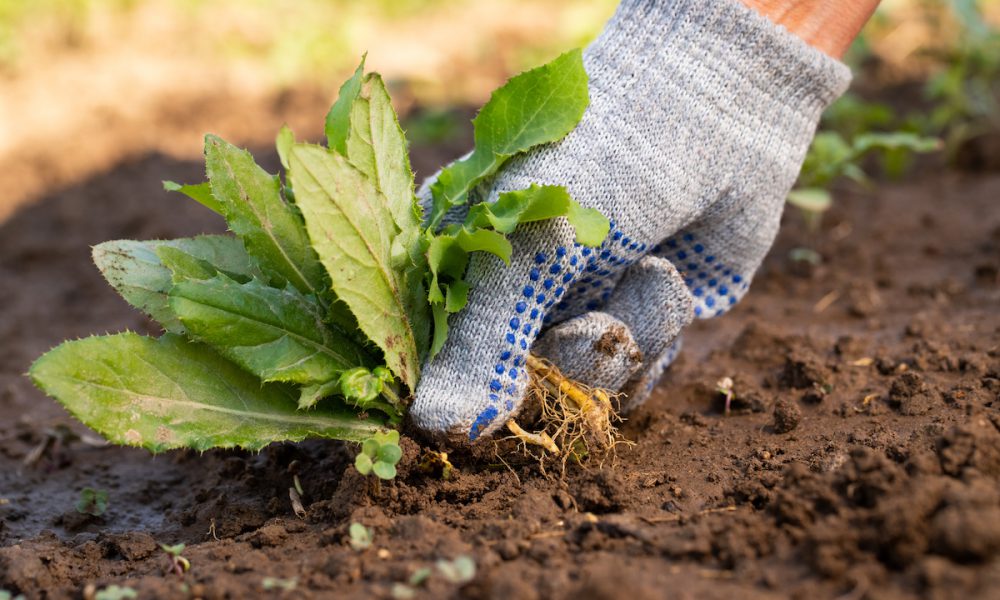
All year long, we look forward to sinking our feet into lush, radiant green grass. But nobody wants stringy ivy, coarse clovers, or fuzzy dandelions grazing your toes instead! And once you’ve spotted one, you’re sure to see more! Weeds seem to keep multiplying until they’re a huge, unattractive problem.
Taming a lawn full of weeds might feel daunting, but it’s all about keeping your turf as healthy as can be. Even though we consider weeds a nuisance, they’re plants–just like grass, flowers, or shrubs! That means they’ll grow just as thick and rampant as our favorite herbs if we let them.
Low-mowed grass, compacted soil, and water-deprived turf all encourage weeds. Reversing these problems and maintaining a healthy lawn is the best way to permanently say goodbye to weeds. Pre-emergent and post-emergent herbicides are designed just for this. Both are made especially for weeds. So, the pre-emergent for crabgrass or post-emergent for dandelions were created just for those plants.
If you’re looking for natural ways to kill weeds, scroll on. And if you go that route, your lawn will be just fine.
Reseeding Could Be a Solution
Take a close look at the lawn. If you see plenty of healthy grass among the weeds or large areas of good grass throughout the lawn, you can save the existing grass and fill in the rest by planting new seeds. That calls for applying a broad leaf herbicide, which kills the weeds without harming the grass.
Reseeding is a job you can do in a weekend if you have an average-sized lawn. You’ll have to wrestle home a couple of engine-powered rental machines. And once your work is done, be prepared to keep the soil damp with daily watering for the first month or so. It’s the key to a successful reseeding job.
Dealing With Weeds
If weeds are starting to overturn your turf, here are four steps to stop them in their tracks: to figure out what weeds you’re dealing with. Since treatments are made to target specific weeds, you’ll need to figure out what’s plaguing your lawn before buying products.
If you plan to target weeds in spring before the growing season, you’ll need a pre-emergent. For established weeds, get a post-emergent. by carefully following the directions for both how much product to apply and when to use. Read the bag at least three times before starting to be safe!
A hose-end sprayer with concentrated weed killer is the fastest and easiest application method. But if your lawn is hopelessly bare or completely covered with weeds, it’s best to go “scorched earth” and kill all the vegetation with a non-selective herbicide and start over. If after two weeks some weeds reappear, apply another treatment.
Natural Weed Destroyers
Spraying vinegar directly on weeds is a natural way to get rid of them. It dries out the plant leaves and kills what’s above the ground. Also, pick vinegar that contains more than the standard 5 percent acetic acid. Head to a home improvement store instead of the supermarket to find vinegar with 10 to 20 percent acetic acid.
This method works best for a few weeds spread throughout the lawn. For larger spreads, it’s best to go with a safe, effective herbicide.
Turn your back for a second, and it’s astonishing how fast weeds can gain a foothold in the lawn. From those early-spring patches of speedwell to May’s golden fields of dandelions to the fat leaves of summer plantain, Mother Nature has a varied lineup to fill any bare soil. Weeds can quickly dominate a thin lawn.
Some of them come and go with each season (annuals), while others are perennial weeds that come back from their roots year to year. Almost all of them hit peak growth in spring when the soil warms. If you let them grow, between the annuals reseeding themselves and the perennials spreading, weeds outcompete the grass.
Spring is the prime time to do that because that’s not only when weeds are actively growing, it’s when they’re most vulnerable to weed-killers. A well-timed spring application of a granular weed-killer such as GreenView Broadleaf Weed Control plus Lawn Food with GreenSmart can clean up the bulk of a weed infestation in one treatment.
It also kills newly germinated annual weeds, such as mustard, mallow, prickly lettuce, and pigweed. And it kills existing perennials, such as plantain, bindweed, ground ivy, and dandelions.
Most of them are aggressive enough to outcompete turfgrass. Granular broadleaf weed-killers work best when applied right after a rain or early in the morning when the granules stick best to damp leaves. They also can be reapplied in early fall to clean up any survivor weeds or to kill off new weeds that germinated over the summer.
Need help boosting your lawn and putting those nagging weeds down? Contact us a Houseman today.